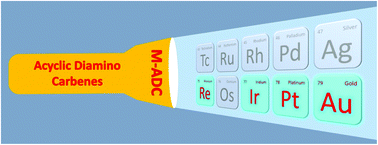Tuning the luminescence of transition metal complexes with acyclic diaminocarbene ligands
Abstract
Metal complexes featuring acyclic diaminocarbene ligands have recently emerged as powerful emitters for prospective use in OLEDs and other electroluminescent technologies. Owing to their strong σ-donating properties and broad synthetic availability, acyclic diaminocarbenes have successfully challenged the application of other ancillary ligands for fine-tuning of luminescence emission. This review systematises the data reported concerning the preparation of luminescent metal complexes bearing acyclic diaminocarbene ligands, uncovers their photophysical properties as a function of the carbene ligand structure and metal characteristics, and draws attention to the potential of ADCs and the advantages that the application of metal-(acyclic diaminocarbenes) provides to the family of transition-metal-based phosphors.

- This article is part of the themed collection: 2022 Inorganic Chemistry Frontiers Review-type Articles


 Please wait while we load your content...
Please wait while we load your content...